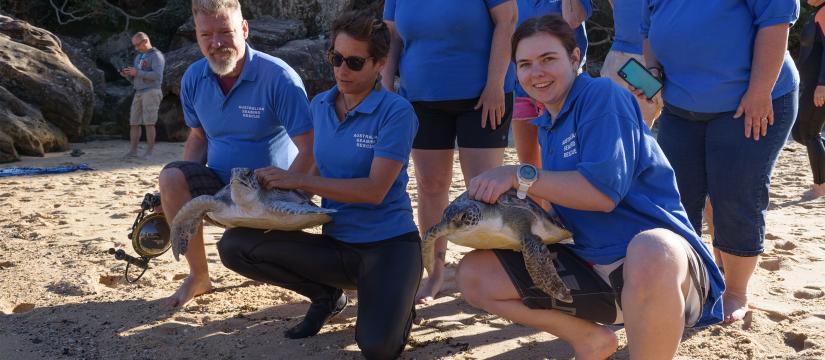
Team Billie – volunteers who helped a sea turtle recover from a fatal blood disease
When Manly green sea turtle Billie was diagnosed with the potentially fatal blood disease septicaemia, a team of divers, wildlife volunteers and enthusiastic locals helped raise funds for his care and nurse him back to health.
Spotted by divers at Cabbage Tree Bay Aquatic Reserve on Sydney’s northern beaches, Billie looked lethargic in the water and was coming to the surface for air too often. Tamila Dalila, a local snorkel guide and volunteer at Oceania Synergy, an organisation set up to help protect the marine life sanctuary, sent photos and videos of the young turtle to Australian Seabird Rescue on the NSW Central Coast. Robert Olive, a volunteer at the wildlife rescue organisation, travelled to Manly to examine Billie.
“We got him out of the water, noticed he had an infection on his plastron, which is underneath the turtle,” he says. “It was quite pink, a sign septicaemia was happening, so we got him in and put him into care.”
As Billie’s condition was potentially lethal, his care was vital. But it was also expensive. Apart from vet bills and food, the course of antibiotics required to beat the infection cost $220 per dose, with Billie’s rehabilitation expected to last three to five months.
Spearheaded by Tamila, Oceania Synergy created a GoFundme page to pay for the turtle’s care. After an overwhelming response from Manly local residents, close to $2,000 was raised which covered all costs.
“Billie’s become quite a celebrity in Manly,” says Robert. “We're always getting messages, ‘How's Billie going?’, and stuff like that. He’s quite famous. He is Manly’s turtle.”
It’s still not certain what caused Billie’s septicaemia but Robert believes bacteria may have entered his body though existing wounds. Another turtle, Ella, nursed to health this year over six months by Robert, had become sick after swallowing a plastic bag and a balloon tied with a long string.
“To a lot of marine animals, plastic looks like a food source,” he says. “Especially with turtles, plastic bags and balloons look like jellyfish. Plastics clog up their digestive system and they die a very slow and painful death.
“Our marine life is coming under a lot of pressure from plastic pollution in the oceans. Taking a reusable shopping bag to the supermarket, having a reusable water bottle or saying no to a plastic straw will make a huge difference to our oceans and the pollution that's going in there.”
After two weeks in Robert’s care, Billie was moved to the home of experienced marine life volunteer and carer Alison Taylor. Alison and her daughter, Kelsey, spent several months nursing him back to health.
Using special turtle tubs filled with salty water, Alison and Kelsey, who has an intellectual disability, administered medicine, food and unwavering love to their very special patients. As time passed, and the young turtle settled in for his recovery, a strong connection was formed.
“Billie has a real personality,” says Alison. “He would watch you as you walked past, waiting for you to feed him. And he was as fussy as could be. He wouldn’t eat prawns from China, he’d only eat Australian prawns. He liked his Barramundi, his flathead, the things that cost the most. He loved his seagrass.
“It was my daughter who really bonded with Billie, more than any other turtle that I've had. She sort of took over caring for him, feeding him and chatting to him.”
In recognition of her daughter’s bond with Billie, it was her daughter who released him back into the Cabbage Tree Bay waters on October 11 before a large crowd of Manly well-wishers. Ella was also returned to the protected bay on the same day.
“I really believe that if you’re fortunate enough to be able to help then you should help,” Alison says. “I’m hoping Billie goes out there and has lots and lots of babies.”


